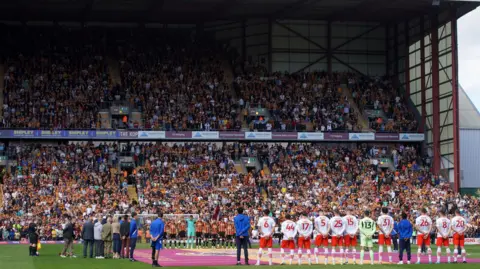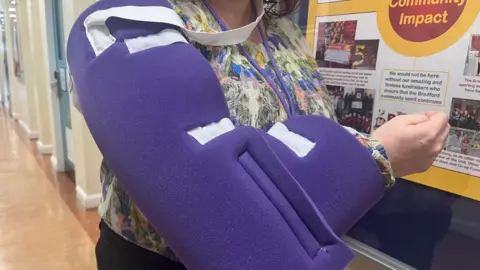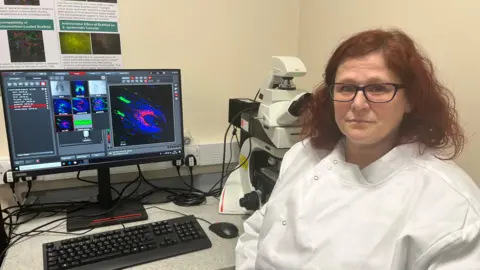How stadium blaze gave rise to pioneering burns unit
 BBC
BBCOn 11 May 1985, Bradford City were hosting Lincoln City in a Third Division game at the Valley Parade stadium.
The game was supposed to be one of celebration, as the Bantams had secured promotion to the Second Division and 11,000 fans had gathered to watch the match.
But five minutes before half time, a fire broke out in the stadium, killing 54 Bradford fans and two travelling Lincoln supporters, while more than 260 were injured.
The fire led to the creation of a pioneering research unit in Bradford, which has developed ground-breaking treatments for burns and scars.
Four decades later, the Bradford City stadium fire is still fresh in the city's memory.
Before Bradford City won promotion to League One on 3 May, fans remembered those killed in the disaster.
 PA Media
PA MediaFew people had a more significant part to play in responding to the disaster than Prof David Sharpe, who organised the response and conducted more than 20 operations in the first few hours after the fire.
The same year, he founded the Plastic Surgery and Burns Research Unit at the University of Bradford and has since been recognised with national and international accolades.
Prof Sharpe died in 2023 aged 77, but the burns unit he set up 40 years ago still stands tall.
 University of Bradford
University of Bradford"It was unfortunate what had happened 40 years ago, but at the time the community spirit was so overwhelming," plastic surgery specialist Prof Ajay Mahajan tells the BBC from the burns unit.
"Obviously the plastic surgery unit came together to look after the patients and in return the community wanted to do something for the plastic surgery department.
"Given the motivation and support, the research unit was established by Prof David Sharpe."
One key achievement of the burns unit - and of Prof Sharpe's legacy - is the "Bradford sling", a simple but vital invention that means an arm can be held vertically rather horizontally to aid healing.
Prof Sharpe noticed while treating patients following the fire that many had injuries to their hands.
The university says the Bradford sling has "revolutionised the management of hand injuries worldwide".

Matthew Wildman managed to escape the fire just after he noticed his skin bubbling, and threw himself over an 8ft (2.4m) wall.
He was 17 years old and suffered 50% skin burns.
Mr Wildman says he owes his life to David Hustler, the man who caught him when he jumped from the wall - but also Prof Sharpe and the team who treated his burns.
"I was good friends with David from that day forward until he sadly passed away," he says.
Seeing the work the burns unit does now, Mr Wildman, now 57, says: "It makes me feel proud.
"No one wants to be a guinea pig, but I had no choice in the matter and the fact that what was tried out on me was effective and made a difference - and still makes a difference to this day - I am so pleased for being part of that.
"Obviously you've got to reflect on the horrible circumstances by which they came about and the fact that people lost family and friends.
"There's not much you can do about it, but you have to remember and respect that when reflecting on what good came out of it."
Still a season ticket holder at Bradford City, Mr Wildman watched his beloved Bantams get promoted with a last-minute winner on 3 May.
But the start of the game was marked with a minute's silence, something which he says "is always emotional".
"You're standing with a lot of people that are all united with the same thoughts and feelings, and that is something to be proud of."
 Matthew Wildman
Matthew WildmanForty years on from the disaster, the burns unit continues to work on treatments to benefit burns victims around the world, Prof Mahajan says.
"Using the lab, we have conducted various scientific experiments for research projects that look to improve wound healing and as a result of that we can reduce scarring.
"It's not only a question of how the scars look but there's a strong functional component to it, because adverse scarring can have a physical impact."
Since its opening in 1985, Prof Mahajan estimates that hundreds of thousands of pounds has been donated by members of the public.
These funds train the plastic surgeons of tomorrow, funding 30 fellowships that have seen plastic surgeons treat burns victims worldwide.
Prof Mahajan says: "There is a significant community feeling in Bradford about what happened 40 years ago.
"It really did bring the community together and that sense of togetherness has prevailed over the years.
"In fact that has been what has kept us going over the years because collectively they raised funds for the unit and supported us and we're very grateful to them for that."

Dr Kirsten Riches-Suman, an associate professor of the Centre for Skin Sciences, was six years old at the time of the fire, and remembers that her mum was due to have surgery - unrelated to the tragedy - which was cancelled due to the number of casualties.
"She said the main thing she noted was the smell," Dr Riches-Suman recalls.
"You could smell burning people."
As a proud Bradfordian, Dr Riches-Suman adds that it is the response to the tragedy that is almost as memorable as the event itself for those living in the city.
"The community spirit and the community support around it is pretty phenomenal," she says.
"I think because of the way that the world is nowadays, you don't see a lot of that community spirit and that charitable spirit around but in Bradford it has really prevailed."
Dr Riches-Suman adds: "I think with Bradford there's always this thing with you get your head down and you get on with it.
"And I think as a community we get stuff done."
'Never, ever forget'
That is a sentiment echoed by nurse Sylvia Coleman, who helped with the response to the fire.
Ms Coleman was just 26 when she was treating the horrific injuries sustained by those at the game.
She particularly remembers a young boy wandering around the stadium looking for his grandma.
"It's something you never, ever forget," she says.
"Everybody just helped each other.
"There was none of this 'it's not my job', everybody just mucked in and got on with things."
Ms Coleman describes Prof Sharpe's Bradford sling as a "godsend".
The burns unit continues to develop new treatments.
Prof Mahajan says one research fellow is looking at how artificial intelligence can help its work, while Dr Riches-Suman says other research is examining how Vitamin D can help wound healing.
Meanwhile, Bradfordians still come together to remember those who died in 1985.
At 11:00 BST, the annual memorial service will take place at the Bradford City fire memorial sculpture in Centenary Square.
Listen to highlights from West Yorkshire on BBC Sounds, catch up with the latest episode of Look North.
